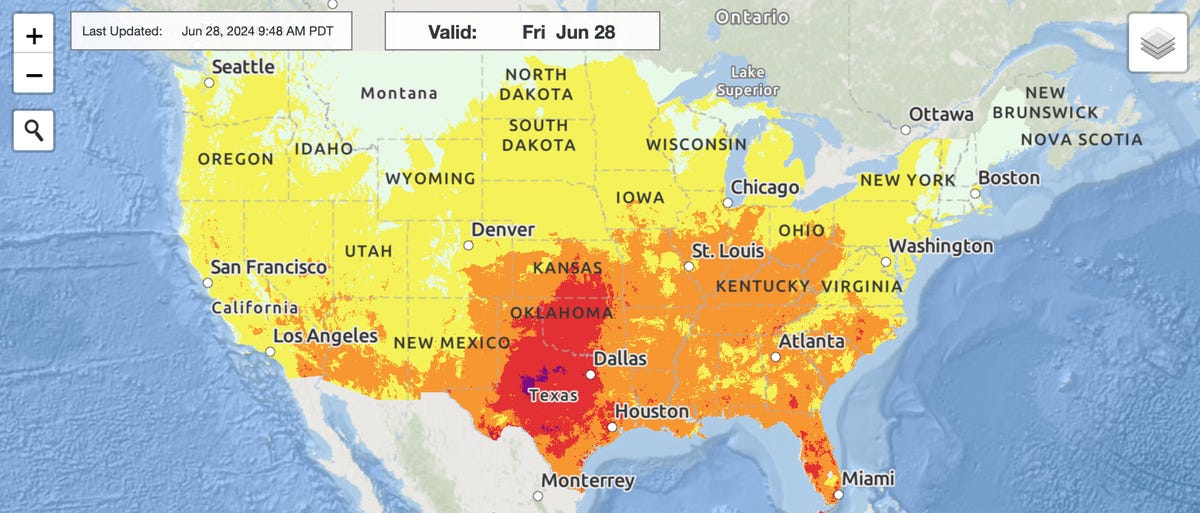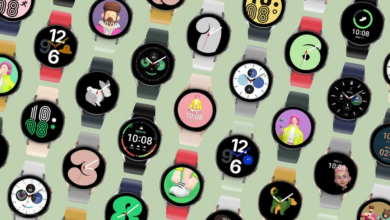This free new warning system helps you prepare for extreme heat


The heat waves sweeping across the U.S. this summer could have a serious impact on public health and how your home and work tools function. Extreme heat is exacerbating common health problems, disrupting your air conditioning, overheating phones and causing other technology to meltdown. A new forecasting tool from the National Weather Service should make it easier to prepare for the extreme heat.
NWS HeatRisk is a clickable map of the U.S., which is used to forecast extreme heat and assess the impact of that weather on public health. The threat rating is based on a five-level system that is color-coded for severity, with green indicating little to no risk and magenta indicating the highest risk. The map includes a seven-day forecast for everywhere in the country, along with the color of the health threat level.
HeatRisk is free to use and worth learning about to help prevent heat safety issues like heat stroke. Here’s how to use it.
Read more: This CDC tool can help you track heat risks while traveling and in your area
What is NWS HeatRisk?

The National Weather Service’s HeatRisk tool is a free index that predicts potential health threats from extreme hot weather. You can click anywhere on the interactive map and get a seven-day forecast of risk assessments for any city, town or area.
HeatRisk analyses how unusual the heat is for the time of year and how long the heat is expected to last. This determines whether there is a higher risk of heat-related effects.
Read more: Common health problems can make a heat wave more dangerous: Here’s how to prepare
Threat colours
NWS HeatRisk has five assessment levels, each with a different color corresponding to the extent of the health risk:
0 Green
According to the NWS tool, there is little to no risk associated with the predicted heat at the green level.
1 Yellow
At the yellow level there is a small risk for people who are extremely sensitive to heat.
2 Orange
The orange level poses a moderate risk to the general population, with potential impacts on healthcare systems and heat-sensitive industries.
3 Red
Red means there is a high risk to people without immediate access to cooling and hydration, with likely impacts on healthcare systems and heat-sensitive industries.
4 Magenta
The most extreme level is magenta. It is both a rare event and one that lasts for a long time, without illumination of the night, which is likely to have consequences not only for health systems and heat-sensitive industries, but also for infrastructure.
Read more: Wild weather ahead: Summer 2024 could be scorching hot as heat wave approaches
Other ways to track heat risks
Similar to NWS HeatRisk, a tool from the U.S. Centers for Disease Control and Prevention called the HeatRisk DashboardThis allows users to consult a seven-day weather forecast to assess the potential health effects of extreme heat.
Another tool, Data Explorer from the CDC Environmental Public Health Monitoring Programprovides more information about HeatRisk and assessment resources for COVID-19 and other diseases.
Read more: How to Keep Your Kitchen Cool (and Lower Your Energy Bill) During a Heatwave
Heat knows no boundaries
The summer of 2024 has been a scorching one for many parts of the country, starting early in the season. While California’s average temperatures aren’t yet as extreme as the East Coast, experts say there won’t be many places safe from a heightened threat, especially with a major heat wave during the week of July 4th throughout California.
Russell Vose is chief of the Monitoring and Assessment Branch at the National Centers for Environmental Information of the National Oceanic and Atmospheric Administration. “As the climate warms, most areas are at greater risk for some type of climate-related extreme weather,” he told CNET’s Katie Collins. “Perhaps the best example is extreme heat — it can happen anywhere.”




